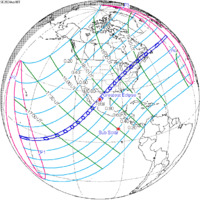
Photo from wikipedia
An experimental study of the phase and amplitude observations of sub‐ionospheric very low and low frequency (VLF/LF) signals is performed to analyze the response of the lower ionosphere during the… Click to show full abstract
An experimental study of the phase and amplitude observations of sub‐ionospheric very low and low frequency (VLF/LF) signals is performed to analyze the response of the lower ionosphere during the 21 August 2017 total solar eclipse in the United States of America. Three different sub‐ionospheric wave paths are investigated. The length of the paths varies from 2,200 to 6,400 km, and the signal frequencies are 21.4, 25.2, and 40.75 kHz. The two paths cross the region of the total eclipse, and the third path is in the region of 40–60% of obscuration. None of the signals reveal any noticeable amplitude changes during the eclipse, while negative phase anomalies (from −33° to −95°) are detected for all three paths. It is shown that the effective reflection height of the ionosphere in low and middle latitudes is increased by about 3–5 km during the eclipse. Estimation of the electron density change in the lower ionosphere caused by the eclipse, using linear recombination law, shows that the average decrease is by 2.1 to 4.5 times.
Journal Title: Earth and Space Science
Year Published: 2020
Link to full text (if available)
Share on Social Media: Sign Up to like & get
recommendations!